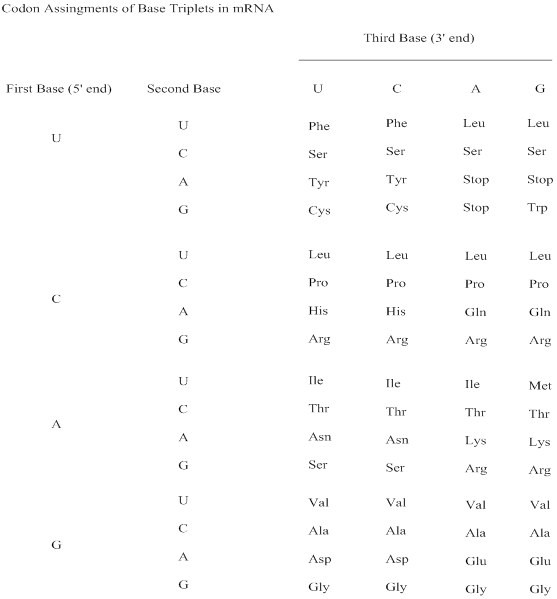
Concept explainers
(a)
Interpretation:
The anticodon sequence for the given codon sequence has to be predicted.
Concept Introduction:
Codon: A sequence of three ribonucleotides in the mRNA chain that codes for a specific amino acid; also a three-
Genetic code: The sequence of nucleotides, coded in triplets (codons) in mRNA that determines the sequence of amino acids in protein synthesis.

Illustrated relationships are:
DNA informational strand: 5’ ATG CCA GTA GGC CAC TTG TCA 3’
DNA Template strand: 3’ TAC GGT CAT CCG GTG AAC AGT 5’
mRNA: 5’ AUG CCA GUA GGC CAC UUG UCA 3’
protein: Met Pro Val Gly His Leu Ser
Notice: 5’ end of the mRNA strand codes for the N-terminal amino acid, whereas the 3’ end of the mRNA strand codes for the C-terminal amino acid. Proteins are always written N-terminal to C-terminal, reading left to right.
(b)
Interpretation:
The anticodon sequence for the given codon sequence has to be predicted.
Concept Introduction:
Codon: A sequence of three ribonucleotides in the mRNA chain that codes for a specific amino acid; also a three-nucleotide sequence that is a stop codon and stops translation.
Genetic code: The sequence of nucleotides, coded in triplets (codons) in mRNA that determines the sequence of amino acids in protein synthesis.

Illustrated relationships are:
DNA informational strand: 5’ ATG CCA GTA GGC CAC TTG TCA 3’
DNA Template strand: 3’ TAC GGT CAT CCG GTG AAC AGT 5’
mRNA: 5’ AUG CCA GUA GGC CAC UUG UCA 3’
protein: Met Pro Val Gly His Leu Ser
Notice: 5’ end of the mRNA strand codes for the N-terminal amino acid, whereas the 3’ end of the mRNA strand codes for the C-terminal amino acid. Proteins are always written N-terminal to C-terminal, reading left to right.
(c)
Interpretation:
The anticodon sequence for the given codon sequence has to be predicted.
Concept Introduction:
Codon: A sequence of three ribonucleotides in the mRNA chain that codes for a specific amino acid; also a three-nucleotide sequence that is a stop codon and stops translation.
Genetic code: The sequence of nucleotides, coded in triplets (codons) in mRNA that determines the sequence of amino acids in protein synthesis.

Illustrated relationships are:
DNA informational strand: 5’ ATG CCA GTA GGC CAC TTG TCA 3’
DNA Template strand: 3’ TAC GGT CAT CCG GTG AAC AGT 5’
mRNA: 5’ AUG CCA GUA GGC CAC UUG UCA 3’
protein: Met Pro Val Gly His Leu Ser
Notice: 5’ end of the mRNA strand codes for the N-terminal amino acid, whereas the 3’ end of the mRNA strand codes for the C-terminal amino acid. Proteins are always written N-terminal to C-terminal, reading left to right.
Want to see the full answer?
Check out a sample textbook solution
Chapter 26 Solutions
FUNDAMENTALS OF GENERAL CHEM VOL 2
- If a polyribonucleotide contains equal amounts ofrandomly positioned adenine and uracil bases, what proportion of its triplets will encode (a) phenylalanine, (b)isoleucine, (c) leucine, (d) tyrosine?arrow_forwardI have four amino acids: serine, histidine, alanine, and tyrosine. How many different primary structures are possible if every amino acid is used only once and tyrosine must be at the N-terminus?arrow_forwardHow many nucleotides in a row make one codon?arrow_forward
- Compare the codons with a pyrimidine, either U or C, as the second base. Do the majority of the amino acids specified by these codons have hydrophobic or hydrophilic side chains?arrow_forwardHow many bases make up a codon?arrow_forwardWhat is the first amino acid in the polypeptide? _____________________ A group of 3 nucleotides codes for one amino acid. How many codons are needed to make the polypeptide that results? _________ What is the resulting polypeptide: _______________________________________________________?arrow_forward
 Human Heredity: Principles and Issues (MindTap Co...BiologyISBN:9781305251052Author:Michael CummingsPublisher:Cengage Learning
Human Heredity: Principles and Issues (MindTap Co...BiologyISBN:9781305251052Author:Michael CummingsPublisher:Cengage Learning
